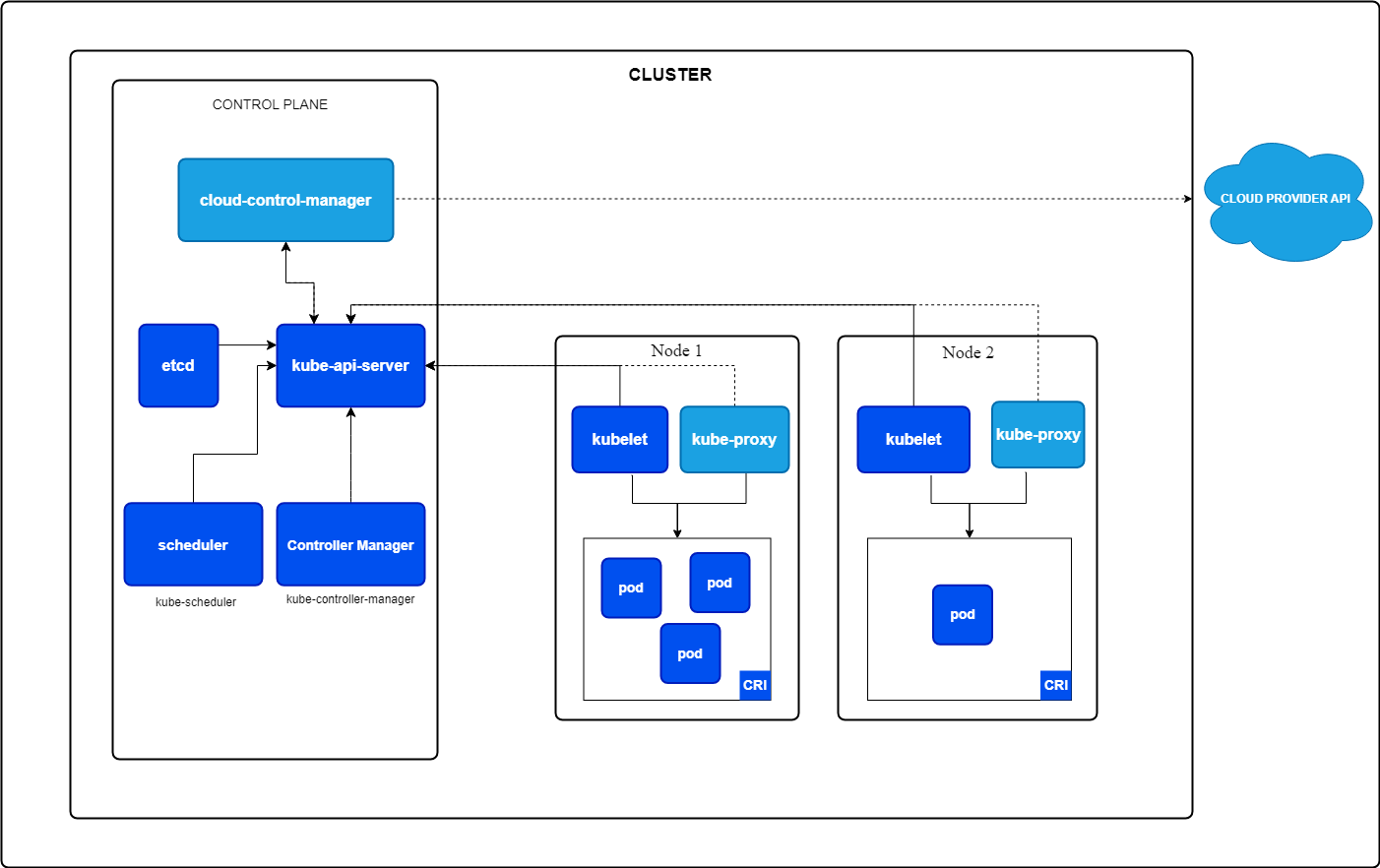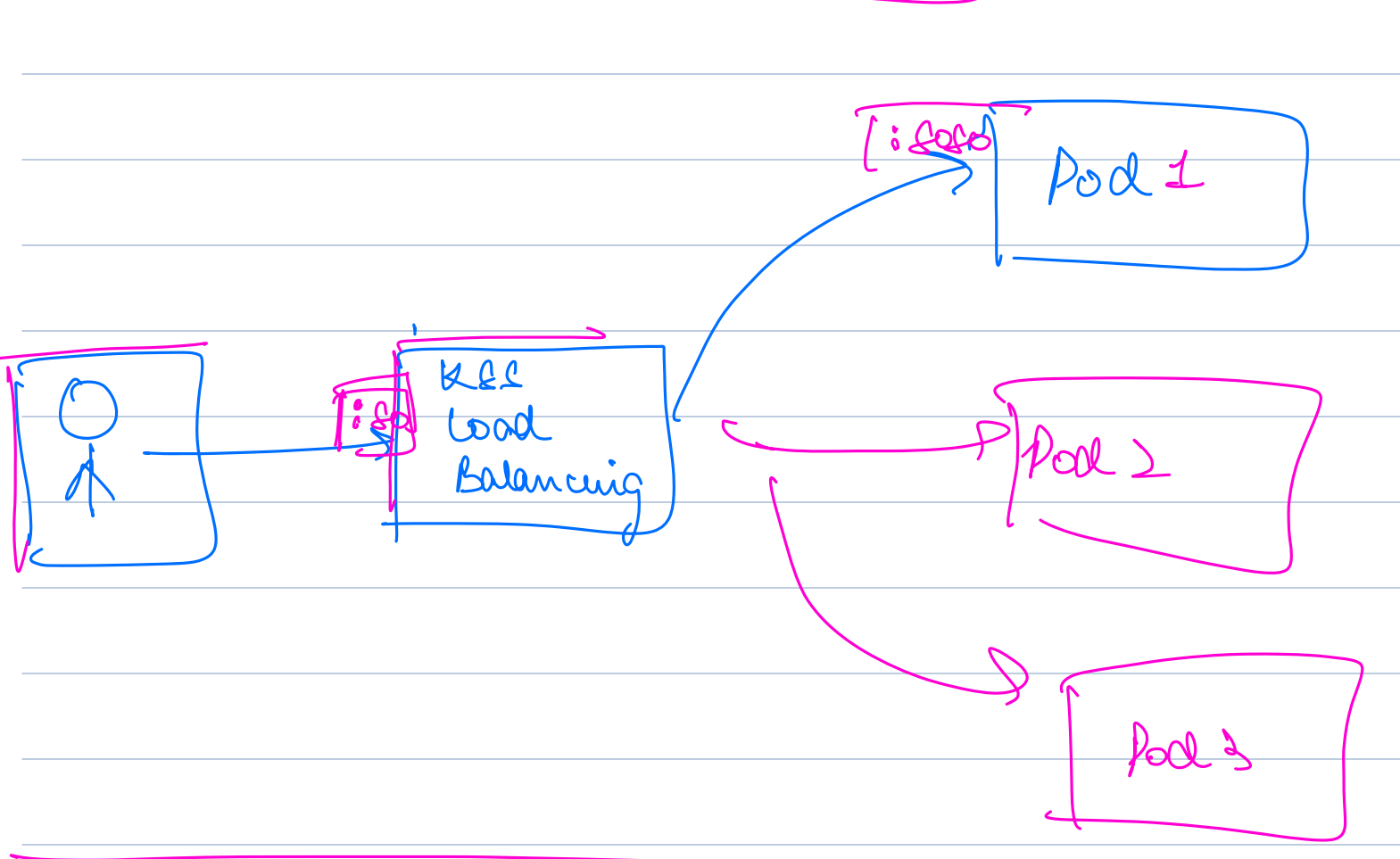Containerization - Kubernetes
Topics to be covered¶
- Why do we need Kubernetes in modern production systems ?
- What is Kubernetes, and how does it work ?
- Understanding key Kubernetes terms and concepts.
- Learning how to orchestrate applications effectively using Kubernetes.
Why Kubernetes?¶
Understanding the Need for Kubernetes in Production Systems¶
-
Software System Architecture:
- Modern software systems are rarely built as single, large applications (commonly known as Monolithic Architecture). Instead, they are often broken down into smaller, independent units called Microservices.
- Each microservice typically runs multiple instances to handle varying loads and ensure reliability. These instances need to be deployed across many servers.
-
Deployment Approaches:
-
One Server per Instance:
- In this approach, we allocate a single server for each microservice instance.
- Advantages: This method is simple to manage since every server runs a single instance, making it easier to monitor and maintain.
- Disadvantages: This setup can lead to resource under-utilization. If a service doesn't need all the available resources on a server, the remaining capacity goes unused, leading to inefficient use of hardware and higher infrastructure costs.
-
Multiple Instances on a Single Server:
- This approach allows multiple microservice instances to run on the same server, improving resource utilization.
- Challenges: It introduces complexity. A lot of planning is required to determine which applications or instances can coexist on the same server without causing conflicts or resource bottlenecks.
-
-
Scaling Challenges at Large Enterprises:
- Consider large companies like Google, which might run 1000+ services and 50,000+ instances distributed globally across data centers.
- Human intervention is impossible at such scale. Managing and monitoring the distribution of services across thousands of servers would be overwhelming.
- This is where automation becomes crucial, and manual methods fail to cope with the dynamic nature of resource allocation.
-
Need for Orchestration:
- Think of an orchestra: a group of musicians playing different instruments. A conductor ensures that every musician plays in harmony.
- In the context of software, there are thousands of microservice instances (instruments) running on numerous servers (musicians). These need to work together seamlessly.
- The tool that serves as this "conductor" in modern, cloud-native architectures is Kubernetes, which orchestrates the deployment, scaling, and management of applications across distributed systems.
What is Kubernetes?¶
Overview of Kubernetes¶
-
Kubernetes (often abbreviated as K8S) is an open-source system for automating the deployment, scaling, and management of containerized applications. It was launched by Google in 2015, following years of experience managing its own internal systems through a similar technology called Borg.
- Borg has been in use at Google since 2004 and continues to manage Google's internal microservices across data centers.
- Kubernetes was developed to solve similar orchestration challenges but was designed as a general-purpose tool that could be used by any organization to manage containerized applications.
-
Key Functionality of Kubernetes:
- Inputs:
- Configuration of the services that need to be deployed (e.g., the number of instances of each service).
- Information about the available servers (the physical or virtual machines where services can run).
- Outputs:
- Kubernetes dynamically assigns services to servers based on load and resource availability, ensuring the most efficient use of resources across the infrastructure.
- Inputs:
-
Fundamental Role of Kubernetes:
- Efficient Resource Utilization: Kubernetes ensures that resources (CPU, memory, etc.) are utilized optimally across all servers.
- For example, if one server is under heavy load while another is idle, Kubernetes can move services to balance the load.
- Health Checks and Recovery: Kubernetes continuously monitors the health of running services. If a service becomes unresponsive, Kubernetes can automatically restart it or move it to a healthier server.
- Efficient Resource Utilization: Kubernetes ensures that resources (CPU, memory, etc.) are utilized optimally across all servers.
Additional Features of Kubernetes¶
-
Cloud Integration:
- Kubernetes has built-in capabilities to integrate with popular cloud providers such as AWS, Google Cloud, and Azure.
- When additional resources are needed (e.g., more servers or instances), Kubernetes can automatically communicate with the cloud provider’s API to provision or decommission servers as necessary.
-
Auto-scaling:
- Kubernetes supports horizontal auto-scaling, similar to the functionality provided by cloud services like AWS Elastic Beanstalk.
- Based on specified parameters (e.g., CPU utilization), Kubernetes can automatically adjust the number of instances running for a particular service.
- This ensures that services can handle increased traffic without manual intervention.
How Kubernetes Works¶
The Architecture of Kubernetes¶
-
To manage an application across many servers, you need an overarching system that can coordinate where each instance of your application runs. This is what Kubernetes achieves through its cluster architecture.
-
Kubernetes Cluster: A collection of servers (also called nodes) managed by Kubernetes.
- Worker Nodes: These are the servers that run the actual application services (e.g., product service, payment service).
- Control Plane (Master Node): This node is responsible for managing the overall cluster, making decisions about where services should be deployed, scaling applications, and monitoring the health of the system.
Key Components of the Control Plane¶
-
Scheduler:
- The scheduler is responsible for assigning services to worker nodes. It checks which nodes have the capacity to handle new service instances and schedules them accordingly.
- It also continuously monitors the health of nodes. If a node goes down, the scheduler reassigns the services running on that node to healthy ones.
-
Cloud Manager:
- This component interacts with cloud providers to provision or destroy servers based on the needs of the cluster.
- For example, if more server capacity is needed, the cloud manager can request additional servers from AWS or Google Cloud.
-
ETCD Database:
- ETCD is a distributed key-value store used by Kubernetes to store all the configuration data for the cluster.
- It holds important information such as:
- Service names
- Deployment rules
- Resource constraints
- Server and instance details
Diagram Reference: The diagram below illustrates the high-level architecture of Kubernetes, including the relationship between the control plane and worker nodes.

- Worker Nodes:
- Each worker node runs services inside Pods (the smallest deployable units in Kubernetes, containing one or more containers).
- A service called Kubelet runs on each worker node, allowing it to communicate with the control plane.
- Multiple pods can run on a single node, and each pod may contain one or more containers running the actual application.
Key Kubernetes Terms¶
Important Kubernetes Concepts and Terminology¶
-
Node:
- A Node is a machine (physical or virtual) in a Kubernetes cluster.
- There are two types of nodes:
- Control Plane Node (Master Node): Responsible for managing the cluster and making decisions about where services should run.
- Worker Node: Runs the application services.
-
Pod:
- A Pod is the smallest deployable unit in Kubernetes. It typically contains one or more containers, which are instances of your application.
- Pods provide isolation between applications, ensuring that each service has its own set of resources and dependencies.
- Kubernetes doesn’t directly manage containers (like Docker does); instead, it manages containers through pods, allowing it to work with any container runtime, not just Docker.
-
Deployment:
- A Deployment is a configuration file (typically written in YAML) that describes how Kubernetes should run an application.
- It specifies things like:
- Which application to run (the container image).
- How many instances of the application should be running.
- The resource requirements for each instance.
-
Service:
- A Service is a network configuration in Kubernetes that defines how external clients interact with the application.
- A service routes requests to the appropriate pods (often through a load balancer) and ensures that traffic is evenly distributed across the available pods.
Example: If your application runs on port 8080 internally, a service can map external requests on port 80 (HTTP) to port 8080 of the pod.

-
Kubernetes can automatically scale the number of pods running based on the load, and it can distribute traffic evenly among the available pods.
Practical Demonstration¶
Steps for Setting Up a Kubernetes Cluster Locally¶
- Installing Minikube:
- Ask students to install Minikube (a tool that allows you to run a Kubernetes cluster locally). It will simulate a full Kubernetes environment on their local machines.
- Installation guide: Minikube Installation
2 Checking Kubernetes: * Once Minikube is installed, ensure Kubernetes is running by executing:
kubectl get pods
-
Deploying a Service:
-
Create two YAML configuration files: one for Deployment and another for Service.
-
Deployment Configuration:
- Name:
productservice. - Set replicas to 5 (indicating 5 instances of the service should run).
- Specify the container image (e.g., a Spring Boot application).
- Name:
-
Service Configuration:
- Name:
ProductService_Service. - Expose the service on port 3000 and forward traffic to the application running inside the container on port 8080.
- Set the service type as LoadBalancer.
- Name:
-
-
Running the Configuration:
- Deploy the application by running the following commands:
kubectl apply -f ProductServiceDeployment.yaml kubectl apply -f ProductService_Service.yaml kubectl get pods
- Deploy the application by running the following commands:
-
Demonstrating Auto-recovery:
- Try deleting one of the pods to simulate a failure:
kubectl delete pod <pod_name> - Kubernetes will automatically create a new instance of the deleted pod, maintaining the desired number of replicas.
- Try deleting one of the pods to simulate a failure:
-
Accessing the Application:
- Retrieve the IP address of the load balancer by running:
minikube service productservice --url - Open this URL in a browser to see the running Spring Boot application, which is automatically load-balanced across multiple instances.
- Retrieve the IP address of the load balancer by running:
-
Viewing the Kubernetes Dashboard:
- Open the Kubernetes dashboard to get a visual overview of the cluster's status:
minikube dashboard
- Open the Kubernetes dashboard to get a visual overview of the cluster's status:
-
Viewing Logs:
- You can also inspect the logs of any running pod to debug or monitor the application's performance.
Further Reading¶
- official documentation for a deeper understanding of:
